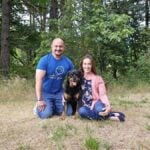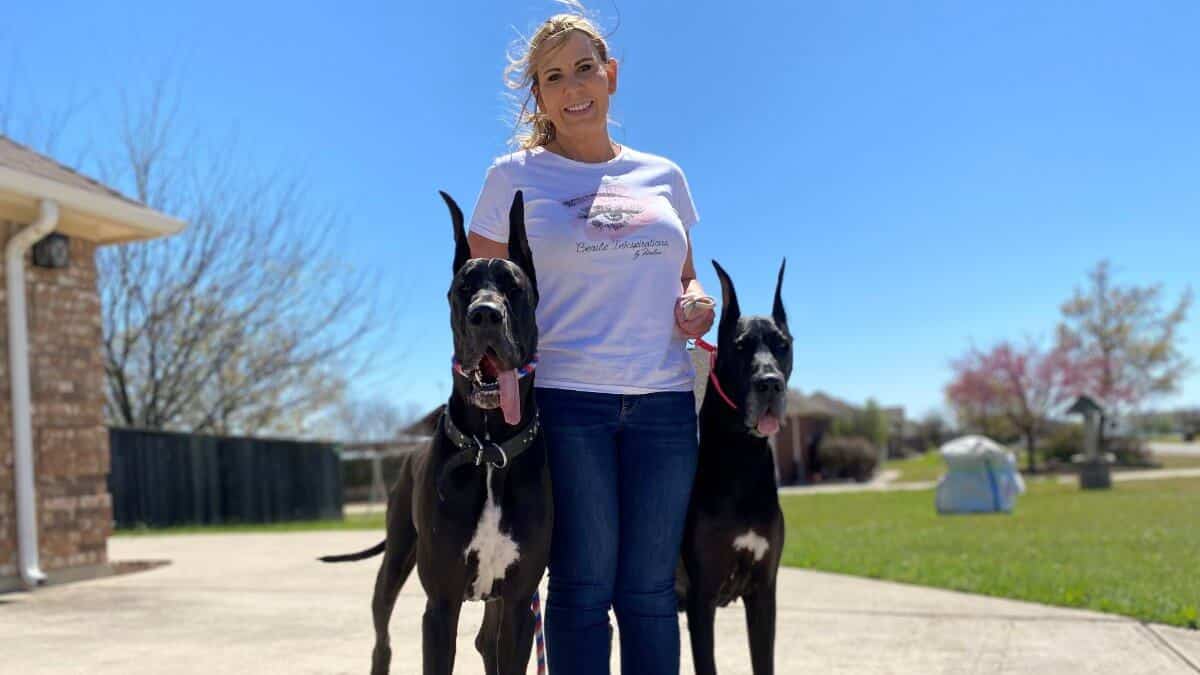


Home » Melissa Dreyer | Sunrise Great Danes & Pat Haltmeier | Haltmeier Danes

1. Melissa Dreyer: I grew up in New Jersey and currently live in Texas. I’ve been in dogs for 44 years. I whelped my first litter in 1983. Sunrise is my kennel name. It was part of my first show dog’s registered name, Gold-Rush Sunrise Sam. Robin (Massingill) came up with “Sunrise” because it went with “Sam.” It stuck and we’ve used it for every litter ever since. We have bred, owned, and specialed dozens of champions in Goldens, Great Danes, and Miniature Bull Terriers.
Pat Haltmeier: Haltmeier Danes was started in 1967 by Bob & Pat Haltmeier in Little Ferry, New Jersey. We started with a black puppy bitch, Cleopatra, who received her C.D. We met Karla Callahan, Nahallac Danes, and she suggested we take her to the Dane classes on Long Island, held at the estate of Poppy and Al Feldman. Bob became Treasurer for GDCA. We imported a blue Dane from Sweden, Ch. Azurs Elbina, and finished her. Over the next 55 years, we have had more than 50 litters of black, blue, and harlequin with over 100 champions bred, co-bred, or sired by our Danes. Some of our most notable have come from collaborations with Sunrise (the family team of Melissa Dreyer, and Robin & Erica Massingill); like our most recent being our “Griffin,” aka RBIS MBISS GCHS CH Haltmeier N Sunrise I’m Heart To Resist, NSSD, ATT.
In 1982, we started the Great Dane Monthly magazine. My husband passed away about five years ago. I now live with my daughter, Renee, also a Great Dane and cat lover, in Marshall, Virginia.
2. Melissa Dreyer: We spend a lot of time with our pups from day one. Handling them, observing them. We like to make notes and start stacking and taking pics every week from four weeks on. Show pups need stable, outgoing personalities. We will sometimes keep more than one pup from a litter. There have been cases where I’ve had littermates, where one was more correct to the Standard but had no attitude and another pup wasn’t the better conformation-wise between the two but had that look-at-me attitude. They both finished. One we specialed, the other we purposely kept to finish and be the one we breed and go forward with.
For Performance, you need drive, stability, adaptability, and people pleasing. The pup that would rather follow me everywhere vs. playing with littermates. The self-entertainers, the explorers. They make my best Performance dogs.
Pat Haltmeier: When I evaluate a litter or puppy, I look for head, topline, and just a good balance from the side view. Then a good front and rear with angles… movement is usually correct if conformation is.
3. Melissa Dreyer: I think there are lots of positives happening with research and DNA testing. The usual culprits of straight shoulders, long bodies, over-angulated rears, and lack of balance are still present. Our breed is not in any position to chase or hold a boar; lack of balance, having fronts that can’t reach because of short, straight upper arms, and poor drive from the rear because of over-angulated rears with slipping hocks. There seems to be little concern from breeders and judges. It’s truly not doing the breed any service by breeding these dogs or awarding them in the ring.
Pat Haltmeier: Our Great Dane breeding pool is not what it used to be. Decades ago, we had many large breeding kennels putting out some really good Danes. The breeders would show what they thought was the best of what they had, and sell many others with great qualities to be shown. Not every dog in the litter was shown. Now people buy a Dane to show, and do so no matter what because they bought it to show. That’s why there are many different breed types in the Dane ring.
4. Melissa Dreyer: I think the sport has evolved to have many facets. There’s something for everyone. I think judging, in many ways, has gotten better. I think there’s more to be done, and I think there’s always room for improvement. The number of shows has gotten out of hand. When you have shows within a day’s drive of each other on the same weekend, it hurts the entry of both clubs. There will be no shows in an area one weekend and then three different directions one can go to on another. Clubs are losing money and venues are costing more. I think AKC needs to address this in some way.
Pat Haltmeier: The judges today at all-breed shows have their work cut out for them, picking the one Great Dane in their opinion that is closest to our Standard. Our Specialties are still bringing out many of the best Danes to be judged. Some of the weekends can be overwhelming with six or eight shows, including two or four Specialties. The cost of putting on a Specialty has more than doubled, so I understand why we have more shows together, mainly to get a better entry to pay for the show site and judges, or to share the expenses. Sometimes this is overwhelming for us, but it does bring larger entries for our major points.
5. Melissa Dreyer:: Social media has really become a double-edged sword. It is free advertising. It keeps us connected. It’s hard not to not know who’s done what and where in real time.
Pat Haltmeier: Because of cell phones, the Internet, and computers, our dog sport info today (show wins, show entries, advertising) is much faster and easier than years ago.
6. Melissa Dreyer: I think the need to get new people involved is one of the biggest challenges, and the need to make purebred preservation breeders (PBPB) painted in a positive light, to be seen as part of a solution and not the cause or adding to the problem of pet overpopulation, etc. I have always thought celebrities would be a way to draw attention and possibly get PBPBs heard and seen in a positive light. To have our cause explained and understood in a positive, more accepting light.
I think we are losing our big dog sport. It’s become too expensive for many new puppy owners to pay the rising costs for dog food, vet bills, training, show entries, and then possibly, a dog handler.
7. Melissa Dreyer: There is more accountability these days, be it for abuse, bullying, or sex offenders, whether it be an exhibitor bullying a judge or a handler accosting a Junior. The AKC zero tolerance policy is a huge step. It’s a much-needed change for the better for all involved in our sport. You can’t attract kids and families if you can’t provide a safe environment.